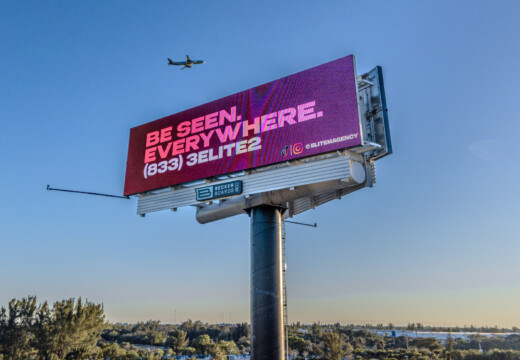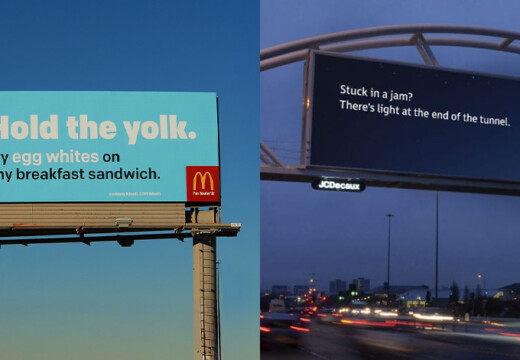When it comes to OOH advertising, the term digital billboard is nearly omnipresent, and for good reason. Gone are the days when static billboards reigned supreme, given the present climate of new media and reliance on all things digital.
While there are many forms of out-of-home advertising, digital billboards have taken center stage. That’s because digital billboards are the fastest-growing segment of the outdoor advertising market, with a revenue growth rate of 7% annually.
Their growth can be attributed to various factors, from ease of use, to better grabbing attention and many other facets.
When it comes to capturing attention, digital OOH reigns supreme, as a whopping 90% of consumers have noticed an out-of-home advertising in the past month and 80% noticed an OOH ad in the past week.
Before you seek out a digital billboard for your advertising needs, or any form of OOH, it is crucial to understand exactly what it is. Let’s explore these billboards, what they entail, how they can help you, how they differ from traditional billboards and more.
The Digital Billboard Explained
A digital billboard is a kind of billboard comprising a large panel that features an LED display and is controlled by a computer or other electronic device. Those who run ads on a digital billboard control them off-premise, usually through OOH, or out-of-home software.
These kinds of billboards can display videos and still images for various advertising and marketing needs (see the uses and applications section). They can host various forms of content, such as words, figures, symbols, patterns, light displays, et al.
As a digital form of advertising, these signs have the power to be controlled and altered remotely, automatically, as well as on the fly. The specific ways that they can be controlled depend on the OOH platform or software you use.
These kinds of billboards are also known as digital signage and LED billboards.
Digital Billboards vs Static Billboards
Static billboards are the predecessors of digital billboards and are still used as an OOH method. As their name implies, they are a fixed, unchanging display, which is not powered by any electronic means.
Also known as traditional billboards, static billboards can also be used for various marketing and advertising campaigns. Billboard owners can offer this OOH method for those more comfortable using the traditional approach with billboards.
Contrary to digital billboards, static billboards aren’t electronic, rather they feature content that is printed and on an analog device, whether it is on paper or some other material.
Given that they are an analog form of advertising, they don’t feature any components of light, unless marketers request adding lighting to their static billboards. This, however, will depend on the billboard owners and whether they offer this option.
Because they are analog, still images without lighting, static billboards do not have the same capabilities as digital billboards. But it is not only their physical restraints that push them behind their digital counterparts. Static billboards also don’t have the same power to capture and hold the attention of drivers, riders or passersby.
Hence, digital billboards are beating static billboards in popularity, demand and usage.
They Couldn’t Exist Without Blips
Blips are central to the concept of digital billboards. Despite this, while many buyers of ad space understand what digital billboards are, they are completely oblivious to what a blip is. Instead, they think that they’re just paying for static ad space.
That’s where they’re wrong. Digital billboards don’t merely differ from static billboards in their digital setup and properties. Instead, their changeable nature is also present in the time and length in which an ad will be displayed. This is due to the use of blips in digital billboards.
What is a Blip?
A blip is essentially a slot in which a single advertisement on a digital billboard will be displayed. A blip is one 8 to 15-second display of your advertising on a rotating digital billboard.
Digital billboards rotate, which means they feature a lineup of different advertisements that are shown repeatedly every minute. The duration of your blip depends on which board you choose, and is set by the board owner.
The History of Digital Billboards
Digital signage is still a new form of billboards, relative to the long history of OOH advertising and an even longer history of advertising. Although billboards have been in use since as early as the 19th century, having come to be in the 1830s and made popular in the 1860s, it wasn’t until the 1990s that digital billboards were flourishing.
This coincided with the boom of the Internet in the 1990s, when the digital space as we know it took root and blossomed. Those in the ad tech space realized that the convenience and utility of acquiring information from a screen can be transferred to advertising, as large digital screens demand attention and can resonate with the masses.
The advent of digital billboards, however, can be traced back further, as these billboards required a media player, which was invented around the time computers were born and operating (1970s-80s). A media player was originally a type of computer, which enabled the content of a billboard to be displayed on a screen. Media players communicate with servers that control the digital content through the internet,
Digital billboards apply either of the following within hardware screen displays, each with its own history:
- LCD (liquid crystal display)
- George H. Heilmeier, Ph.D. is usually credited with inventing LCD screens, claiming he stumbled upon the discovery of liquid crystals that have some electro-optic characteristics in 1964. He wound up in the National Inventors Hall of Fame.
- However, it was the RCA researcher Richard Williams who first discovered this in 1888, yet doesn’t get as much credit.
- LED (light-emitting diode)
- The LED screen came about due to the invention of the LED light bulb by the scientist Nick Holonyak, Jr. in 1962. These screens form images by way of several small diodes. They’re used in various devices, such as digital clocks, which use LED lights.
Digital billboard software is rather difficult to trace. However, it was in the ‘70s when networking media players connected to screens in different locations. Today there are a myriad of software choices, all of them catering specifically to the niche requirements of a company and the needs of the end user.
The term digital signage itself stems from a 1992 shopping center in the UK, in which a security guard referred to a network of walls with videos displayed on them in this way, for lack of a common term used back then. The guard did not trademark this term.
Pros and Cons of Digital Billboards
Whether you’re a business owner or a marketer, you ought to understand both the benefits and the setbacks of digital signage. Here’s a breakdown of the advantages and downsides of digital billboards.
The Pros
- Cost-effective relative to other forms of digital and OOH advertising
- This will depend on the billboard software you use.
- They grant you full control over your ads
- Vibrant and dynamic
- You get to change your billboard on the fly via your software provider
- Eye-catching and demanding attention
- Easier to spot and see from further away due to the lighting factor
- The ability to quickly if not instantaneously launch a digital ad campaign
- Fend off the boredom of those caught in traffic
- A great means to build your brand awareness and equity
- Easy to set up and launch.
- Create positive associations and recall of your brand.
- Since they’re digital, you can leverage the digital ads you already created for other channels (Google, Facebook) and use them on these signs rather than creating something separate for print.
The Cons
- Competing with blips of other companies for your viewer’s attention.
- Some may find a blip to offer too short a time to display an ad (although they rotate throughout a certain period).
- The need to think more strategically and creatively given that there are other blips.
- Prone to being shut down whenever there is a power issue (rarely).
Uses and Applications
Digital billboards have the capacity to go beyond just looking nice on some highway or other highly trafficked area.
-
- Advertising: This is the most salient use of these billboards, as their bright and vibrant nature, along with their ability to pop up at regular intervals is widely used for displaying all sorts of ads.
- Public Service Announcements: Local, state and even national governments can deploy public service announcements and other critical information to their constituents.
- Branding: Brand marketing is an ongoing, long-term effort and digital signage is a key tool that enables marketers to bolster a wide range of branding projects. This includes the following:
-
-
- Forming a positive reputation for your company
- Building your personal style, tone and design
- Formulating your brand’s identity and place in your market
- Crating brand recall when your brand is mentioned by name or not.
-
- Product marketing: Digital signs empower you to bring any product to market and deepen your customers’ understanding of it. You can use these signs to promote new products or updates to existing ones.
- Reinforcing relationships with customers: Show your customers you care about them with empathetic messages during troubled times.
How to Plan and Form a Digital Billboard Campaign
Planning and executing a digital billboard campaign isn’t as complex as it appears. You just need to follow a few steps to run it smoothly. Here’s a quick guide:
- Start by defining your objectives: You’ll need to first define the objectives of your campaign. Consider which applications you’ll use these digital signs for (branding, digital marketing/bringing more site visitors, product promotion, etc.).
- Understand who your target market is: Make sure you have the necessary insights into who makes up your customer base and target audience. You may need to conduct primary and secondary research on demographics, needs, pain points and behaviors. This will help tailor your messaging by narrowing down who it is you’re targeting.
- Select your intended locations: Choose the right locations for your signage based on where your target market is most likely to see it. Consider factors such as where your business is located( if you have a physical location), whether you want to branch out into other regions, the foot and vehicle traffic patterns of a particular location, along with that location’s demographics.
- Design compelling content for your billboards: Create visually appealing and attention-grabbing creative content. Make sure your messaging is clear and easy to understand. Use a clear focal point and concise copy and consider how well it will be seen from a distance.
- Optimize for blips: Remember that digital billboards operate via blips, meaning your billboard will be shown for several seconds, as it is in rotation with other ads. Make sure your content is easy to digest at a glance. We recommend using high-resolution images, bold colors and minimal text.
- Create a few versions: Develop multiple versions of your billboard to keep it fresh and ward off viewer fatigue and boredom. Opt for a few designs throughout your campaign.
- Use a budget: Set up a realistic budget for your digital billboards and weigh it against other advertising needs and costs. You should also consider your overall marketing expenditures. Additionally, consider how much you’re willing to spend on your digital billboard campaign, including the costs of production, design and media placement. Other factors to note are the number of locations, duration of the campaign and additional things like dynamic or interactive elements.
- Schedule your billboards: Schedule your campaign with several factors in mind, such as seasonal themes, trends, events and promotional periods. Ensure your ads are displayed at the optimal times.
- Track and measure performance: Set up tracking mechanisms to monitor the performance of your digital billboard campaign. Track metrics such as impressions, website visits, store visits and conversions to evaluate the effectiveness of your campaign and make any necessary adjustments. Some OOH software platforms will help you with tracking campaign success.
- Optimize and iterate: Stay up to date with the data you collect and analyze during your campaign to uncover areas for improvement. Use this information to optimize existing and upcoming campaigns and refine your digital billboard strategy over time.
How to Create a Digital Billboard with Blip Billboards
It’s so easy to create your digital ad campaign with Blip Billboards, along with customizing and analyzing the key metrics involved in your campaigns. Just follow the steps below:
-
- Click on the + Start Advertising button on the Blip platform. You’ll find it in the Home and Campaigns section in the left-hand navigation.
- Once you click on it, you’ll be taken to the campaigns interface, where there are three main options in the upper navigation:
- Locations
- Design
- Review
- Begin with the first option, Location, to select your billboard’s location; you’ll be routed here first.
- Choose your location by entering your city, state or zip code. An interactive map will then show you all the locations we offer via map pins.
- Click on the map pins that represent the locations you wish to add to your campaign. This will summon a box you can click on for more information on the billboard offered there. *Please note that the amount of information displayed here will vary, as it is controlled by billboard owners.
- If you want to use it, just click on + Add Sign.
- This will activate key data points about the billboard’s location you selected, such as: Estimated Monthly Results, Blips and Impressions.
- Next to it on the left, set your daily budget.
- Move on to the Design section in the upper navigation.
- Here you get to upload your artwork, i.e., the content that will be displayed on your blip.
- This shows the pixel dimensions needed for your campaign.
- If you wish, use Blip’s artwork generator to create a new display via our system.
- Go to the final section in the upper navigation, Review and launch your campaign
- Here you will need to fill out all the billing information; consider it a checkout.
- You’ll also see an overview of your entire campaign, such as the campaign name, locations, daily spend limit and schedule.
- Edit any of the sections as you wish.
- Choose to either save the campaign or launch it.
- You will then be in the approval stage: a two-tiered process.
- Tier 1: Our in-house moderation team will review your artwork, according to Blip design guidelines. This takes roughly 30 minutes, within normal business hours.
- Tier 2: If approved, your artwork will be sent to the billboard owner for review. This can take 2-3 business days or be approved on the same day.
- Post Campaign: Check Historical Data in the left-hand navigation for analytics
-
- This features two places to get your data:
- Daily Snapshot: A day-by-day breakdown of your campaign, showing the date, blip amount, how much the blip cost you, your account balance and how the balance was affected. You can view this by:
- 1 Day
- 1 Week
- 1 Month
- 2 Month
- 3 Month
- Detailed reports: This features raw data, with date range selection for:
- Monthly Invoice
- Campaign Summary
- Campaign Spend
- Proof of Performance
- Summary of ad plays and cost
- Detailed Proof of Performance
- Timestamp and cost of each ad play
- Daily Snapshot: A day-by-day breakdown of your campaign, showing the date, blip amount, how much the blip cost you, your account balance and how the balance was affected. You can view this by:
- This features two places to get your data:
We hope this tutorial was an eye-opener on digital billboards, their importance and value, along with how to create them on the Blip platform.
Now let’s get started!


